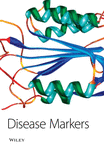Increased Frequency of HLA B 17 Antigen in Girls with Turner Syndrome and their Fathers
Abstract
HLA-A, -B and -DR antigen distribution was studied in 49 girls with Turner Syndrome (TS), in 43 of their parents, as well as in 433 controls. No increased frequency of DR3, DR4 was found in our group. However, an increased frequency of HLA B 17 antigen was disclosed (18.3% in TS versus 6.4% in the controls, p<0.001 and Pc<0.01). Furthermore, the HLA B 17 antigen was of paternal origin in 77.7% of the cases . The interpretation of the present findings is quite difficult. Most likely, the findings are related to the chromosomal abnormality rather than to autoimmunity. It is quite possible that genes within the region of class I genes create unfavorable circumstances leading to the loss of the sex chromosome or, alternatively, genes in this region confer protection and prevent miscarriage of the affected fetus.




